A viable ecological landscape: sankyo-son, azumadachi, and kainyo

Rakudo An is a hotel nestled in one of the largest dispersed settlements in Japan which spreads across the Tonami plain in the western part of Toyama prefecture.
The term sankyo-son refers to a type of settlement in which houses are separated from each other and scattered throughout the plain, and is thought to have arisen as an extension of villages in which houses are clustered together.
The sankyo-son on the Tonami plain is characterized by the vast expanses of rice fields and the developments scattered throughout–traditional houses called azumadachi and the plantings of trees which surround each one, called kainyo.
This landscape shows the ground rules of the earth, its water veins, made visible through human labor, and shows how our ancestors achieved regenerative living within the ecosystem through wisdom and honest effort long before we used words like “regenerative” and “sustainable.”
The formation of the sonkyo-son through the harsh yet abundant blessing of water
The sonkyo-son settlements lie scattered throughout the alluvial fan formed between the Oyabe and Shogawa rivers in the Tonami plain.

The foothills of the area have a long history as a grain-producing region, with evidence of rice paddy cultivation dating back to the Yayoi period (710-794), while the estates of Todaiji Temple spread across the area during the Nara period (710-794.) Meanwhile, the plains, where the rivers regularly flooded, were uninhabited and uncultivated for a long time.
When civil engineering technology to control water and flooding developed and farmland could be cultivated in the late Sengoku to Edo period (17th to 18th century), rice paddies expanded and the sonkyo-son was formed.
Due to the sediment deposited by the rivers, alluvial fans are generally too well drained for rice cultivation, and are mostly used for growing fruit. However, thanks to the formation of waterways made possible by the abundant water of the Shogawa river and people’s pioneering spirit and dedicated efforts, rice cultivation flourished and the sonkyo-son spread, creating a place to live in what had been a barren alluvial fan.
In fact, most water-based sonkyo-son (scattered settlements amid rice paddies) in Japan are formed in alluvial fans. It is thought that sonkyo-son develop in these areas when the human and geographical conditions are right, such as an abundant flow of water enabling the creation of waterways.
The mountainous areas of Toyama are a land of deep snow, with snowfall reaching 3m (around 10ft) some years. As a result, the rivers never run dry throughout the year thanks to the snow melt and the forests which have a high capacity for water retention.
While snow can sometimes pose a threat of disaster, it is also a blessing that continues to provide an endless supply of water. Toyama’s natural environment, which is abundant in blessings amidst harshness, has had a significant impact on the formation of the land’s spiritual climate.
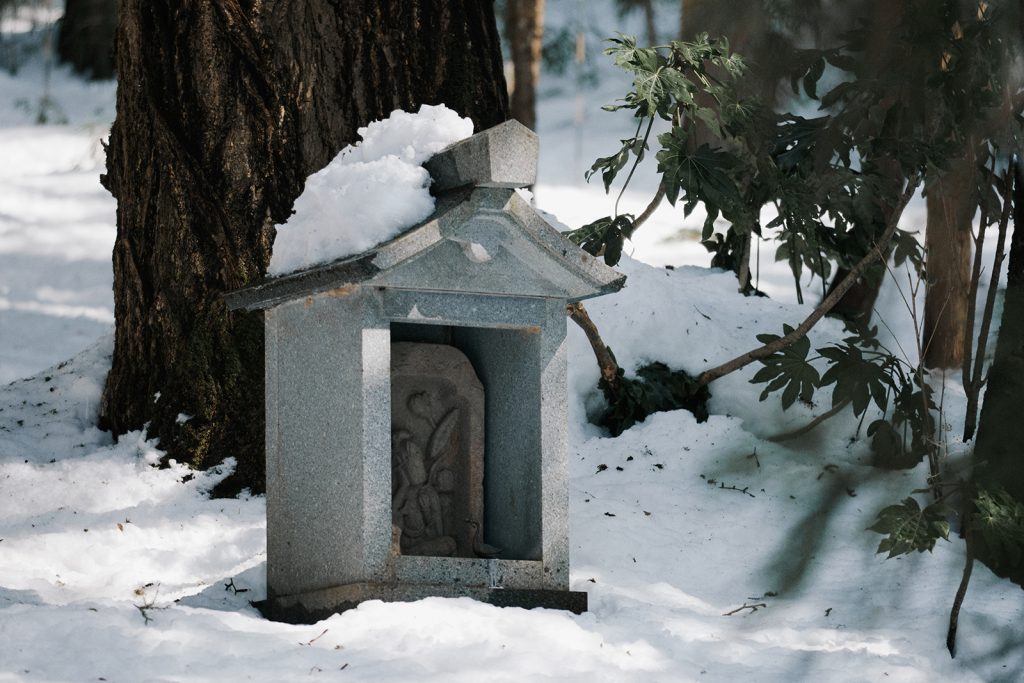
People first built their houses in slightly elevated areas, and cultivated the land around them. But since the topsoil suitable for cultivation was scattered here and there, and the rice fields had such poor water retention that they were called “basket fields,” the need for water management led to people building their homes close to the rice fields thus forming the sonkyo-son.
As the flow of the Shogawa River became more stable through the Kaga domain’s flood control projects, the many riverbeds that had created the alluvial fan were used for irrigation, and tributaries were established creating a complex network of irrigation canals. These waterways, which spread out like the veins of a leaf, took advantage of the gentle slope of the alluvial fan to supply water to the entire plain.From the 1950s onwards, field improvement projects were implemented to accommodate agricultural expansion.
The waterway network and the shape of the rice fields have changed, but the locations of the houses and structures remain the same as they were in the past.
Azumadachi and sacred space
In the sonkyo-son, you can see many east-facing houses called azumadachi.
As their name, “azuma=east, dachi=standing” suggests, the building faces east, which is based on the religious life of the area. The entrance is to the east while the Buddhist altar, the center of the house, has its back to the west. The southwest side is flanked by trees to protect from seasonal winds.
The houses have large sloping roofs covered in black tiles and a lattice-like arrangement of beams over a white plaster gable. The main hall is built using a frame construction method called “wakuno uchi” which does not use nails or other metal fittings. You can feel the strength and vitality of the materials in the bold beauty of the forms.
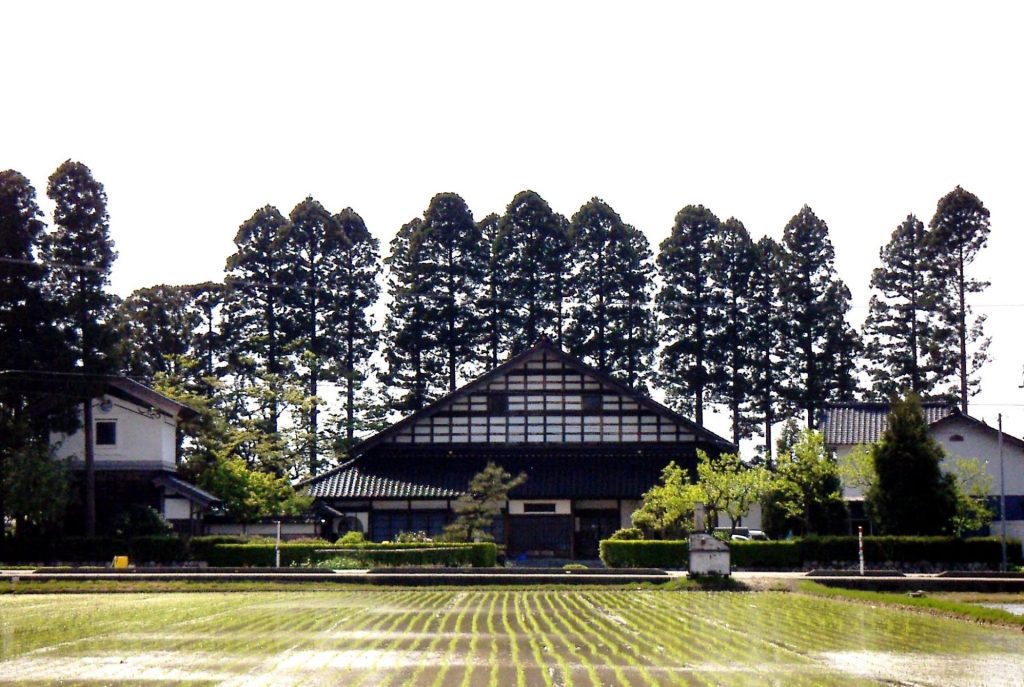
According to data from the Ministry of Land, Infrastructure, Transport and Tourism, Toyama boasts the largest floor space in Japan. This also has a connection to local faith.
In the past, the Tonami region had a system of mutual aid called “ko” that was mainly cultivated within Jodo Shinshu Buddhism. Since ko meetings were held at each house in rotation, houses became larger and larger so that more people could gather.
Both the “butsudan” where the altar was placed and the hall where people would gather were considered sacred spaces. The home was not considered a private space only for family, but a public space shared with ancestors and people in the community.
Ko meetings allowed people to interact with each other, solve problems together, share work methodologies, and develop their skills.
Such opportunities for mutual encouragement and the exchange of information fostered an honest work ethic and a positive attitude toward creativity and ingenuity, giving rise to a rich way of life and a cultural landscape in which nature and human activity were in harmony.
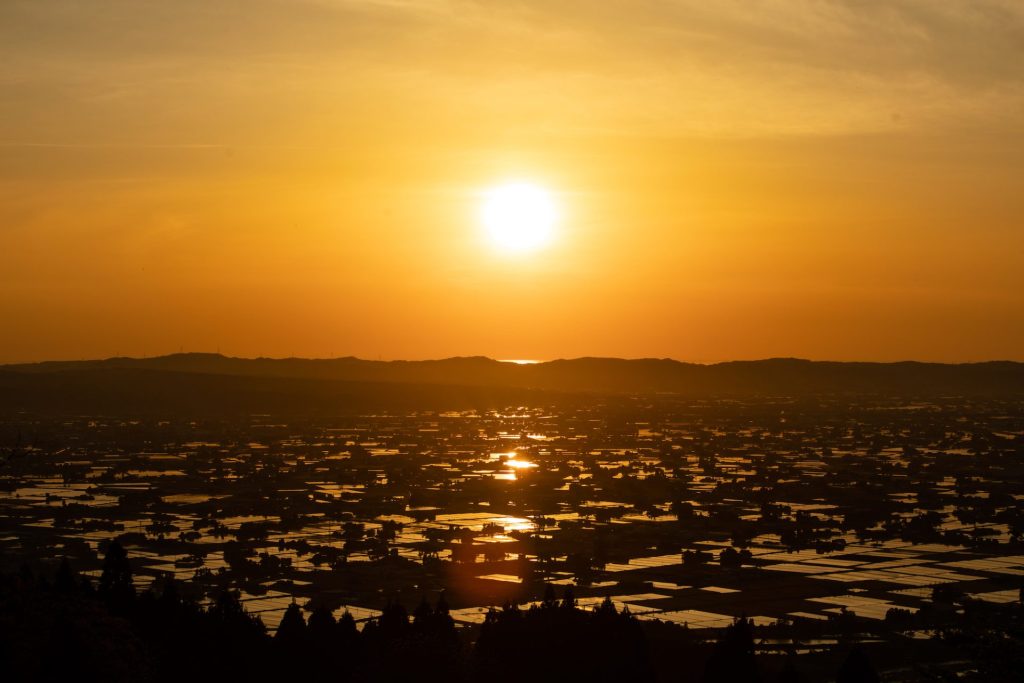
Kainyo, a cyclical ecosystem on each property
In addition to being a characteristic of the sonkyo-son, kainyo, the groves of trees flanking the houses, play an important role as small ecosystems.
In the Tonami Plain, strong seasonal winds blow from the southwest in winter with nothing to block them. To protect the house from wind and snow, people planted tall trees such as cedar and cypress on the southwestern side of their houses. Plum, camellia, and magnolia were planted as flowering trees; persimmons, chestnuts, peaches, pomegranates, kumquats, and figs were planted for their fruit; dokudami, plantain, saxifrage, oleander, and other medicinal plants as undergrowth; and as additional edible plants, butterbur, Japanese parsley, and Japanese honeywort. The Kainyo formed by these trees were like small mountain forests on the plain and nurtured the lives not only of people but also of insects, birds, and various other creatures.
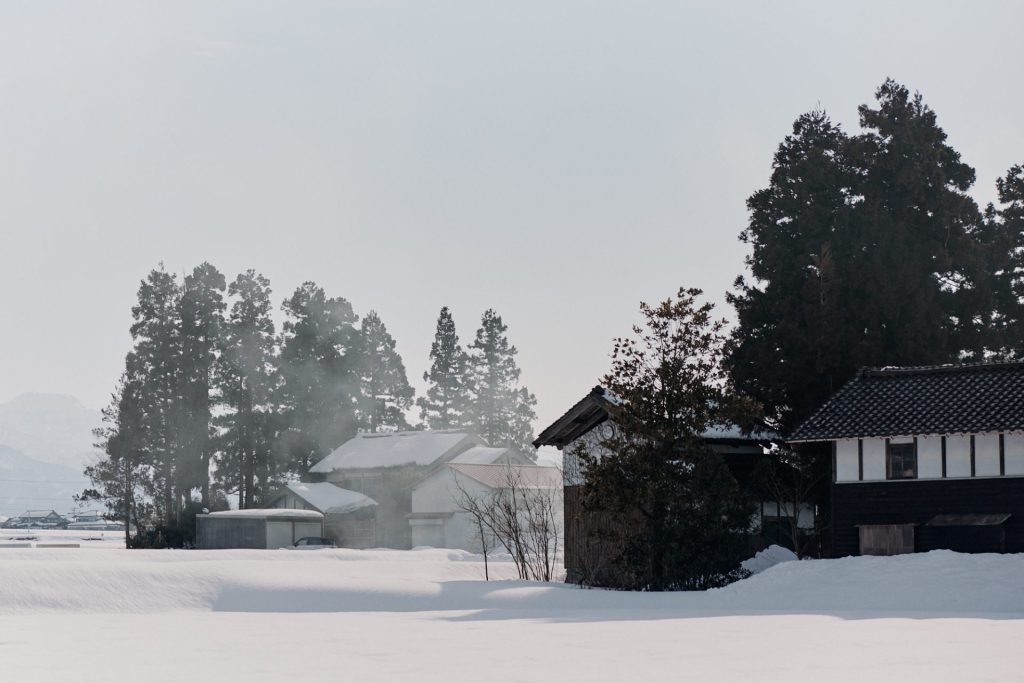
The book “Discussions of Private Residential Agriculture” written by Miyanaga Masatsugu, an agricultural scientist from Shimokawasaki Village, Tonami, in 1789, described the “many virtues” of kainyo.
First, they are a defense against wind and cold, and a precaution against thieves and protection against fire in neighboring houses; pine needles also help with starting fires, while saplings can be cut to provide additional lumber, and fallen leaves can be used in stoves or to supplement compost in the fields.
Kainyo not only protected the house, but also became a source of fuel, firewood, and building materials for repairs and furniture. In addition, fallen leaves and the ashes from burning them were used as fertilizer in the fields, creating an ecological cycle that was integrated with daily life.
Furthermore, kainyo helped to prevent soil erosion. Rice fields in alluvial fans have soil which is difficult to stabilize, so in order to maintain healthy kainyo in such marshy areas, it is necessary to make appropriate environmental improvements such as embankments, and ensure the right flow of water and air.
Well-tended kainyo stabilize the environment of the entire plain, helping to mitigate flood damage, induce a good flow of groundwater, and increase the productivity of the fields.

Some data* shows that there is an average temperature difference of around 10°C and up to 20°C between properties with a kainyo and those without (Japan Environmental Management Association for Industry, “Environmental Management No. 68”.)
Trees continuously circulate water throughout their bodies, and their function can never be replaced by man-made structures such as roofs or windbreaks, which can sometimes cause updrafts.
*Japan Environmental Management Association for Industry, “Environmental Management No. 68”
In the Tonami region there is a saying, “Even if you sell your house, don’t cut down your kainyo.” This saying reveals a deeper meaning beyond the visible usefulness of the kainyo, and indicates that it has also protected people’s lives by preventing and mitigating disasters, warding off strong and rising winds on the plains, and preventing heatstroke.
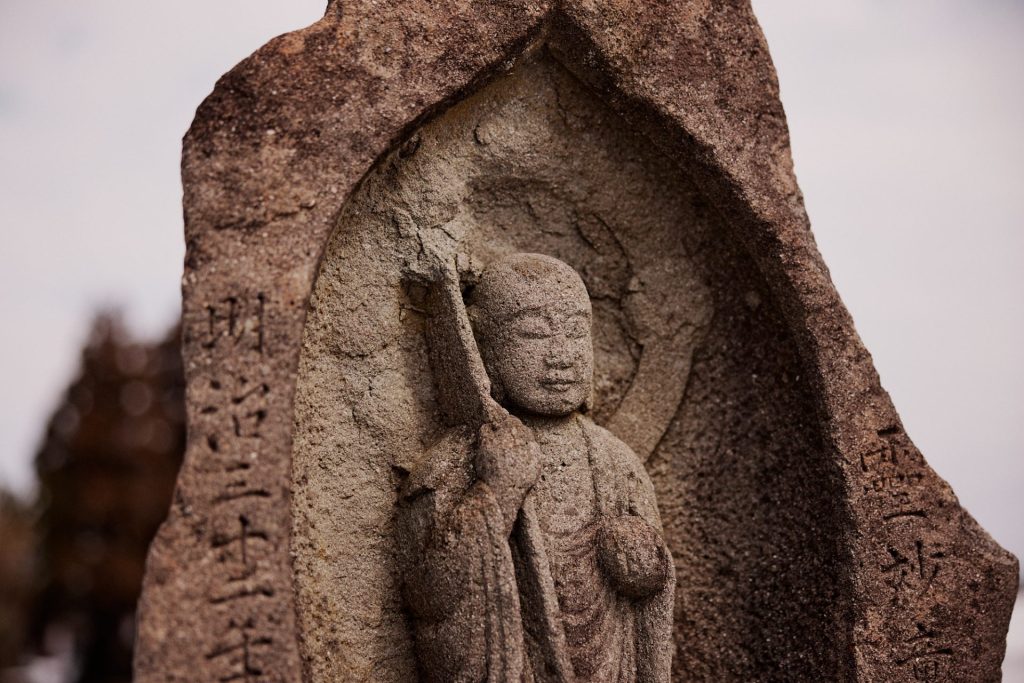
The landscape of the sonkyo-son is a “living landscape” that has been created by local people over a long period of time. Protecting this landscape is directly linked to protecting their way of life.
There are said to be 5,000 stone Buddha statues in the Tonami region, and even today, people look after them and give them offerings and flowers. Japanese taiko drumming, lion dancing, and various festivals still live on. Local beliefs, culture, and community have been nurtured in the landscape of the sonkyo-son.
Bioscapes, that is, spaces created through the coexistence of life, ecology, and human activity, are beautiful. If we find beauty in them, it is probably because they express values that are necessary for us.
However, amidst the rapid changes in society as a whole, even in the landscape of the Tonami plains, the cultural and ecological landscape of the sonkyo-son, its livelihood, and its spiritual climate are all in danger of disappearing due to the falling birthrate, aging population, increase in non-farming households, shift towards nuclear families, and the cutting of kainyo trees due to the increased burden of maintenance and management.
We want to protect it, not merely because it has been there for a long time, but because it is something valuable to everyone which should not be lost. In order to achieve this, the cooperation of people both inside and outside the community is indispensable.
Rakudo An collaborates with many people both inside and outside the local community and is creating a system for conservation and implementing a variety of measures.
We hope that the joy which overflows here will enrich the hearts of all who visit and become nourishment for your life.
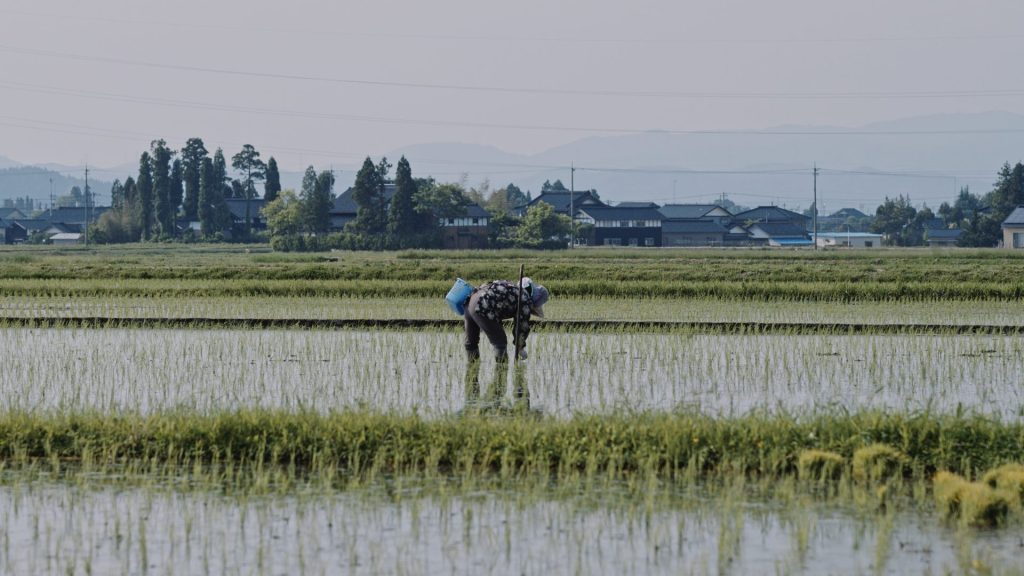
Sources
Interview with Kazunari Uratsuji (NPO Zentokuji Cultural Preservation Research Promotion Association)
Materials published by the Tonami Sonkyo-son Museum
Toyama Prefecture Civil Engineering Department, Architecture and Housing Division, “A century of progress in homes and townscapes”
Saeki Yasukazu, “Phases of Toyama Minzoku“
Interview with Hiroshi Ota, “What is Shinshu immigration?”
Takada Hiroomi, “Earth conservation: The power of trees to mitigate the summer heat ~Part 1: From the example of the kainyo of the Tonami Plain~”
Itoshima Koji, “Philosophy and landscape of water-based scattered villages” (BIOCITY2019 NO.80)
Iwatsuki Kunio, “Kainyo that support the lives of scattered settlements” (BIOCITY2019 NO.80)
History of the towns of Fukumitsu, Johana, and Inami Town, and the villages of Iguchi, Taira, Kamitaira, and Toga

